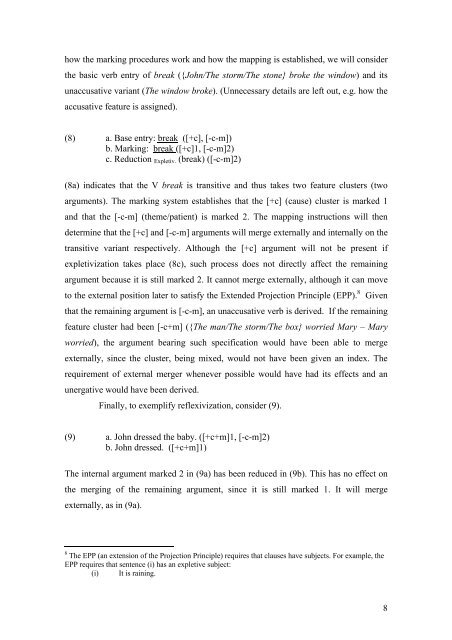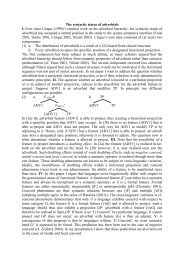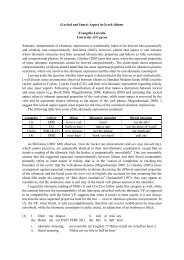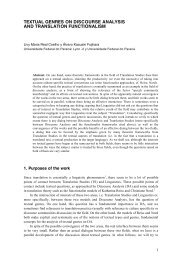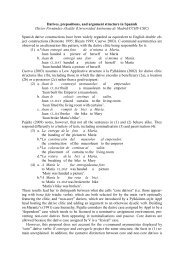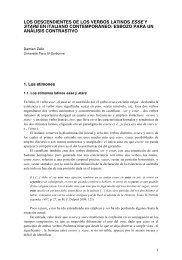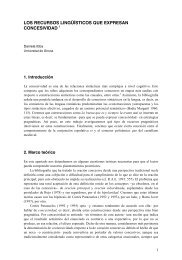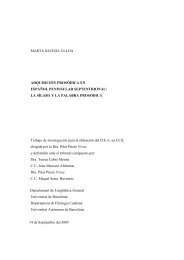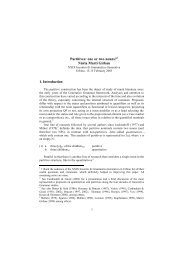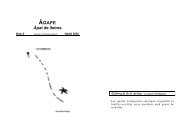Prefixation in English and Catalan - Departament de Filologia ...
Prefixation in English and Catalan - Departament de Filologia ...
Prefixation in English and Catalan - Departament de Filologia ...
Create successful ePaper yourself
Turn your PDF publications into a flip-book with our unique Google optimized e-Paper software.
how the mark<strong>in</strong>g procedures work <strong>and</strong> how the mapp<strong>in</strong>g is established, we will consi<strong>de</strong>r<br />
the basic verb entry of break ({John/The storm/The stone} broke the w<strong>in</strong>dow) <strong>and</strong> its<br />
unaccusative variant (The w<strong>in</strong>dow broke). (Unnecessary <strong>de</strong>tails are left out, e.g. how the<br />
accusative feature is assigned).<br />
(8) a. Base entry: break ([+c], [-c-m])<br />
b. Mark<strong>in</strong>g: break ([+c]1, [-c-m]2)<br />
c. Reduction Expletiv. (break) ([-c-m]2)<br />
(8a) <strong>in</strong>dicates that the V break is transitive <strong>and</strong> thus takes two feature clusters (two<br />
arguments). The mark<strong>in</strong>g system establishes that the [+c] (cause) cluster is marked 1<br />
<strong>and</strong> that the [-c-m] (theme/patient) is marked 2. The mapp<strong>in</strong>g <strong>in</strong>structions will then<br />
<strong>de</strong>term<strong>in</strong>e that the [+c] <strong>and</strong> [-c-m] arguments will merge externally <strong>and</strong> <strong>in</strong>ternally on the<br />
transitive variant respectively. Although the [+c] argument will not be present if<br />
expletivization takes place (8c), such process does not directly affect the rema<strong>in</strong><strong>in</strong>g<br />
argument because it is still marked 2. It cannot merge externally, although it can move<br />
to the external position later to satisfy the Exten<strong>de</strong>d Projection Pr<strong>in</strong>ciple (EPP). 8 Given<br />
that the rema<strong>in</strong><strong>in</strong>g argument is [-c-m], an unaccusative verb is <strong>de</strong>rived. If the rema<strong>in</strong><strong>in</strong>g<br />
feature cluster had been [-c+m] ({The man/The storm/The box} worried Mary – Mary<br />
worried), the argument bear<strong>in</strong>g such specification would have been able to merge<br />
externally, s<strong>in</strong>ce the cluster, be<strong>in</strong>g mixed, would not have been given an <strong>in</strong><strong>de</strong>x. The<br />
requirement of external merger whenever possible would have had its effects <strong>and</strong> an<br />
unergative would have been <strong>de</strong>rived.<br />
F<strong>in</strong>ally, to exemplify reflexivization, consi<strong>de</strong>r (9).<br />
(9) a. John dressed the baby. ([+c+m]1, [-c-m]2)<br />
b. John dressed. ([+c+m]1)<br />
The <strong>in</strong>ternal argument marked 2 <strong>in</strong> (9a) has been reduced <strong>in</strong> (9b). This has no effect on<br />
the merg<strong>in</strong>g of the rema<strong>in</strong><strong>in</strong>g argument, s<strong>in</strong>ce it is still marked 1. It will merge<br />
externally, as <strong>in</strong> (9a).<br />
8 The EPP (an extension of the Projection Pr<strong>in</strong>ciple) requires that clauses have subjects. For example, the<br />
EPP requires that sentence (i) has an expletive subject:<br />
(i) It is ra<strong>in</strong><strong>in</strong>g.<br />
8


